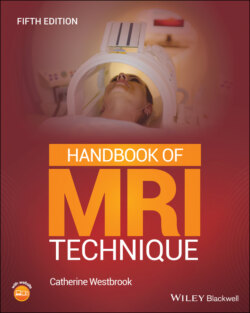Читать книгу Handbook of MRI Technique - Catherine Westbrook - Страница 32
A note on fat suppression techniques
ОглавлениеThe CNR can be improved by suppressing signal from tissues that are not important, thereby increasing the visualization of tissues that are. Fat is the most common tissue that is nulled or suppressed in MRI and this is assumed for the majority of protocols described in Part 2, where all of the techniques described below are referred to as fat suppression.
Fat suppression is most commonly used to distinguish between fat and enhancing pathology in T1‐weighted pulse sequences and in a FSE/TSE T2‐weighted pulse sequence where fat and pathology are often isointense. However, signal from any tissue can be suppressed using the inversion recovery (IR) pulse sequence and some saturation techniques are used to null signal from water or background tissue. Further details on suppression of tissues other than fat are provided where relevant in Part 2.
There are several ways in which fat and other tissues are suppressed, including:
Chemical pre‐saturation: a 90° RF pulse is delivered at the specific precessional frequency of the magnetic moments of spins in either fat or water. This pulse is delivered to spins inside the imaging volume before the RF excitation pulse is applied, saturating them. No signal is therefore received from either fat or water when the echo is read.
Spectral pre‐saturation: an RF pulse of a greater magnitude than 90° is applied and inverts the magnetization in a tissue as in inversion recovery (IR) pulse sequences (see Pulse sequences). At the time from inversion (TI) that corresponds to the null point of the tissue, a 90° RF excitation pulse is applied. No signal is therefore received from that tissue when the echo is read.
Dixon technique (either 2‐point or 3‐point): a reconstructed image is obtained from only the spin population in water. This ‘water‐only’ image has no contribution from spins in fat. Images look similar to the pre‐saturation techniques described above but rely on the chemical shift between fat and water (the difference in the precessional frequencies of the magnetic moments of the spin population in fat and water). Images are acquired depending on whether the magnetic moments of fat and water spins are in or out of phase with each other. Unlike saturation techniques, this technique can be used after gadolinium (Gd) and at any field strength and is a very robust suppression method. Some systems use this technique to produce four images in one acquisition (water, fat, in and out of phase).
